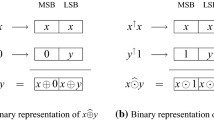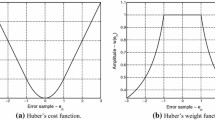Abstract
We present a form of attaining success levels of up to 100% in character classification by the appropriate use of thresholds in the activity functions of the neurons making up the two-layer network with which bidirectional associative memories are implemented, together with a systematic method for generating the weight matrix. The system that is constructed includes a geometrical pre-processing stage that eliminates distortions, thereby improving the results. As a final characteristic, the functioning of the system presents a high level of immunity to noise or deformations. The system was evaluated using the two popular databases NIST#19 and UCI. There was found to be no misclassification in any case, whether under conditions of heavy contamination from noise or distortion of the image to be classified.
Similar content being viewed by others
References
Kosko, B.: Bidirectional Associative Memories, IEEE Trans. on Systems, Man and Cybernetics, 18(1) (1988), 49–60.
Wang, Y. F., Cruz, J. B. and Mulligan, J. H.: Two Coding Strategies for Bidirectional Associtive Memory, IEEE Trans. on Neural Networks, 1(1) (1991), 81–82.
Wang, Y. F., Cruz, J. B. and Mulligan, J. H.: Guaranteed Recall of all Training Patterns for Bidirectional Associative Memory, IEEE Trans. on Neural Networks, 2(6) (1991), 559–567.
Wang, Y. F., Cruz, J. B. and Mulligan, J. H.: Multiple Training Concept for Back-Propagation Neural Networks for use in Associative Memories, Neural Networks, 6 (1993), 1169–1175.
Leung, C. S. and Cheung, K. F.: Householder Encoding for Discrete Bidirectional Associative Memory, Proc. of the Intl. Joint Conf. on Neural Networks, IJCNN'91, 1 (1991), 124–137.
Leung, C. S.: Encoding Method for Bidirectional Associative Memory Using Projection on Convex Sets, IEEE Trans. on Neural Networks, 4(5) (1993), 879–881.
Shi, H., Zhao, Y. and Zhuang, X.: A General Model for Bidirectional Associative Memories, IEEE Trans. on System, Man and Cybernetics, 28(4) (1998), 511–519.
Arthithan, G. and Dasgupta, G.: On Problem of Spurious Patterns in Neural Associative Memory Models, IEEE Trans. on Neural Networks, 8(6) (1997), 1483–1491.
Jeng, Y. C. and Teh, C. C.: Modified Intraconnected Bidirectional Associative Memory, IEE Electronic Letters, 27(20) (1998), 1818–1819.
Lee, D. L.: Generalized Intraconnected Bidirectional Associative Memories, IEE Electronic Letters, 34(8) (1998), 736–738.
Heekuck, O. H. and Kothari, S. C.: Adaptation of the Relaxation Method for Learning in Bidirectional Associative Memory, IEEE Trans. on Neural Networks, 5(4) (1994), 576–583.
Simpson, P. K.: Higher-Ordered and Intraconnected Bidirectional Associative Memories, IEEE Trans. on System, Man and Cybernetics 2, 20(3) (1990), 637–653.
Park, J., Kim, H-Y, Park, Y. and Lee, S-W.: A Synthesis procedure for Associative Memories Based on Space-varying Cellular Neural Networks, Neural Networks, 14(1) (2001), 107–113.
Arica, N. and Yarman-Vural, T.: An Overview of Character recognition Focused on Offline Handwriting, IEEE Trans. on Systems, Man and Cybernetics - Part C, 31(2) (2001), 216–233.
Wu, Y. and Pados, D. A.: A Feedforward Bidirectional Associative Memory, IEEE Trans. on Neural Networks, 11(4) (2000), 859–866.
Nadal, J. P. and Toulouse, G.: Information Storage in Sparsely Coded Memory Nets, Networks, 1 (1990), 61–74.
Buckingham, J. and Willshaw, D.: On Setting Unit Thresholds in an Incompletely Connected Associative Net, Networks, 4 (1993), 441–459.
Chua, L. O. and Yang, L.: Cellular Neural Networks: Theory and Applications, IEEE Trans. on Circuits and Systems, 35 (1988), 1257–1290.
Kumar, S.: Memory Anhilitation of Structured Maps in Bidirectional Associative Memories, IEEE Trans. on Neural Networks, 11(4) (2000), 1023–1038.
López-Aligué, F., Alvarez, I., Acevedo, I., Orellana, C. J. and Macías, M. M.: Adaptive BAM for Pattern Classification, Proc. of the Intl. Joint Conf. on Neural Networks, IJCNN'2000, 5 (2000), 529–535.
NIST Special Data Base #19: Image Processing Group. Advanced Systems Division. National Institute of Standards and Technology (1995).
Merz, C. J. and Murphy, P. M.: UCI Repository of Machine Learning Databases (1998). Available at http://www.ics.uci.edu/_mlearn/MLRepository.html
Author information
Authors and Affiliations
Rights and permissions
About this article
Cite this article
López-Aligué, F.J., Alvarez-Troncoso, I., Isabel Acevedo-Sotoca, M. et al. A Method for the Improvement of the Behavior of Bidirectional Associative Memories as Pattern Classifiers. Neural Processing Letters 17, 137–148 (2003). https://doi.org/10.1023/A:1023605710549
Issue Date:
DOI: https://doi.org/10.1023/A:1023605710549




